Notocactus (Notocactus) is a fairly small genus that is directly related to the Cactaceae family. This genus includes about 25 different plant species. There are sources containing information that notocactus is only a subgenus of parody (Parodia) - a larger genus. Other sources claim notocactus and parody are one and the same. And there are those who distinguish notocactus into a separate genus.
In nature, such cacti can be found on the hills, as well as in the foothills of Paraguay, southern Brazil, Argentina and Uruguay. They are distinguished by a single short-cylindrical or spherical stem. In adult specimens, it can reach no more than 100 centimeters in height. In most cases, such cacti lack both branches and children. Pronounced ribbed stems are dark green in color. At the apex of the ribs, there are many small tubercles, on which areoles with pubescence. Bunches of spines emerge from the areoles, which include from 1 to 5 brownish-red central and 40 pieces of short yellow radial ones.
As a rule, flowers are formed at the top of the stem or at its top. The flower itself is multi-petaled and has the shape of a bell or a funnel. On the surface of a thick, short, fleshy pedicel, there is a layer consisting of many spines and bristles. The color of the flowers can be orange, red or yellow, while the bases of the petals are of a contrasting or more saturated color. The stigma is reddish in most cases. The flower, after blooming, withers only after 7 days.
Caring for notocactus at home
This plant is not capricious and it is very easy to care for it. By the way, this favorably distinguishes it from the rest of the cacti of this family.
Illumination
Like almost all cacti, this one also loves light. To place it, you need to choose well-lit places with direct rays of the sun (shading is required from scorching rays). It is recommended to give preference to windows of the south-west and south-east orientation, while when placed on the southern windowsill, the plant must be shaded at midday.
In order for the flower buds to ripen, in winter it will be necessary to supplement the cactus with phytolamps, while the duration of daylight hours should be 10 hours.
Temperature regime
In summer, notocactus feels best at temperatures between 22 and 25 degrees. However, if the room is often ventilated or the cactus is moved to the street, then a short increase in air temperature to 38 degrees will not harm it.
A cool wintering from 8 to 10 degrees is recommended.
How to water
In the spring-summer period, water is plentiful and make sure that the soil is not completely dry. In the autumn-winter period, it is necessary to reduce watering, but it should be borne in mind that notocactus reacts negatively to the complete drying out of the soil.
For irrigation, water is used at room temperature, which should settle well.
Humidity
Calmly tolerates low air humidity. It is not necessary to moisten the plant from the sprayer.
Earth mix
Suitable soil is neutral and loose, and should contain a lot of river coarse sand. So, a purchased soil mixture for succulents and cacti is quite suitable, while so much sand must be added to it so that it is clearly distinguishable. You can also make an earthen mixture with your own hands:
- Option 1 - combine sand and clay soil in a ratio of 3: 1;
- Option 2 - mix in equal proportions of leaf, turf and peat soil and sand, and also add brick chips.
Fertilizer
The plant is fed in the spring-summer period 1 time in 2 weeks. To do this, use a special fertilizer for cacti, which contains a lot of potassium.
Transplant features
You need to transplant the Notocactus as needed, for example, when its roots or stem no longer fit in the pot. There are no specific intervals between transplants, because some of the species grows very quickly, while the other grows slowly.
Reproduction methods
Most often, such a plant is propagated by children. This is very easy to do. To do this, you need to carefully pinch off the baby from the mother plant, and then plant it for rooting in a mixture that contains a lot of sand. You do not need to use a mini-greenhouse or cover the baby with film. The plant takes root easily with good light and sufficient heat. However, this method of reproduction is complicated by the fact that there are many species that branch very, very rarely. Such plants are best purchased in a specialized store or from flower growers.
Notocactus seeds are propagated only in greenhouse (industrial) conditions. The fact is that the seeds and young seedlings are incredibly small and almost impossible to see with the naked eye. They also have extremely slow growth.
Diseases and pests
This plant can settle shield, spider mite or a worm. When harmful insects appear, it will be necessary to carry out treatment with insecticidal agents as soon as possible, for example, Fitoverm or Aktellik.
The plant may develop rot in the area of the roots or stem. This is due to the wrong temperature or water regime.
Main types
A large number of species and varieties are grown at home. This plant is relatively popular, as it is unpretentious and has a completely compact size.
Notocactus Otto (Notocactus ottonis)
In nature, it can be found in the southeastern regions of South America. The stem is in the shape of a ball, which can reach 15 centimeters in diameter. Unlike many other species, such a cactus has a large number of basal children, and it also releases short underground shoots (stolons), and young plants develop at their ends. Adult plants have 8–12 wide rounded ribs with needle-shaped spines on them. There are 3 or 4 central and from 10 to 18 radial spines. The petals are yellow, but there are varieties with a red or snow-white color.
Notocactus leninghaus (Notocactus leninghausii)
In nature, it can only be found in Rio Grande do Sul (a state in southern Brazil). It is the tallest plant of its kind.An adult plant has a relatively slender stem, which has the shape of a cylinder, which can reach a height of 100 centimeters. It reaches 12 centimeters in diameter and has about 30 ribs. Only adult cacti bloom, the height of which exceeds 20 centimeters. Yellow flowers reach 5 centimeters in diameter.
Notocactus slender (Notocactus concinnus)
It is also called the solar notocactus (Notocactus apricus) - it also grows only in the state of Brazil, Rio Grande do Sul. The stem, which has the shape of a ball, reaches 6 centimeters in height, and its diameter is 6-10 centimeters. It has 15–20 ribs with whitish-yellow areoles with spines. So, 4 central spines (1.7 cm long) and 10 to 12 radial spines (0.7 mm long) emerge from each areola. Saturated yellow flowers reach 7 centimeters in diameter.
Yubelman's Notocactus (Notocactus uebelmannianus)
In natural conditions, such a plant can be found in such Brazilian states as Kakapava and Rio Grande do Sul. The stems have a spherical-flattened shape, while they reach a height of 8 to 10 centimeters, and in diameter - 14 centimeters. 15 ribs at the base of the stem are flat, and at the top - rounded-convex. Areoles, which have an oval shape, stand out for their rather large sizes, for example, they reach 1 centimeter in length, and thick spines emerge from them. 1 central spine 4 centimeters long and from 4 to 6 one and a half centimeter radial. The central spine is located at the bottom of the areola and looks down. The flowers reach a diameter of 5 to 7 centimeters, and they are painted in dark red (species form) or orange-yellow or yellow (varieties).
Notocactus platy or flat (Notocactus tabularis)
In nature, it can be found in the southern regions of Brazil and Uruguay. It is a dwarf species. So, the diameter of the stem, which has a flattened-spherical shape, reaches only 8 centimeters. It has 16–23 pieces of flat, low ribs. From the areoles, 4 central slightly curved spines emerge, reaching 1.2 centimeters in length, as well as about 20 centimeter needle-shaped radial spines. Yellow flowers reach 6 centimeters in diameter.
Rekh notocactus (Notocactus rechensis)
In nature, it can only be found in the Rio Grande do Sul. This species is also dwarf. Its cylindrical stem is up to 7 centimeters long and 3.5 to 5 centimeters in diameter. On the surface there are 18 slightly curved ribs (they are deflected from the vertical position). There are needle-shaped spines, so, there are 3-4 central ones, while their length is 1.5 centimeters, and radial ones - from 4 to 6 pieces (6 or 7 millimeters long). Yellow flowers reach 3 centimeters in diameter. This species differs in that it branches strongly at the base and can form not very large clusters.

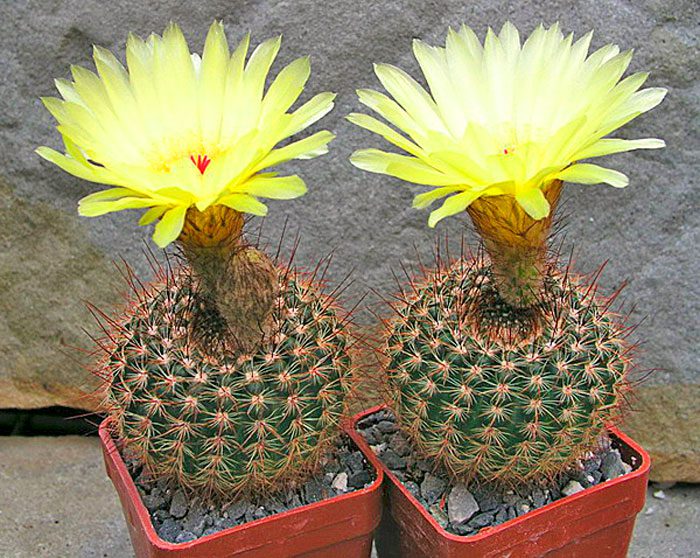

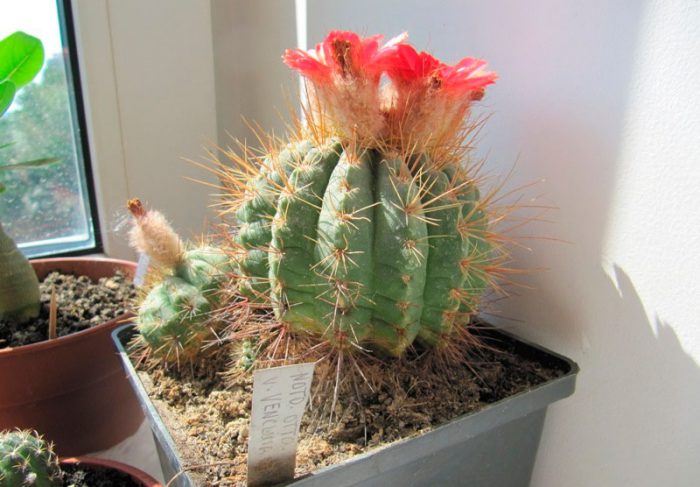

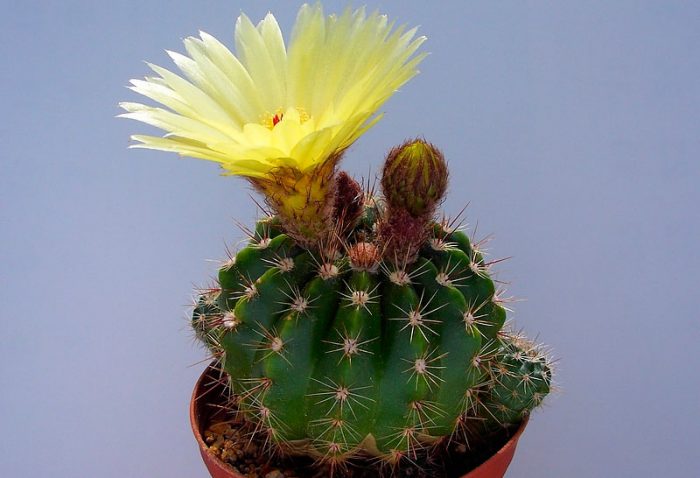
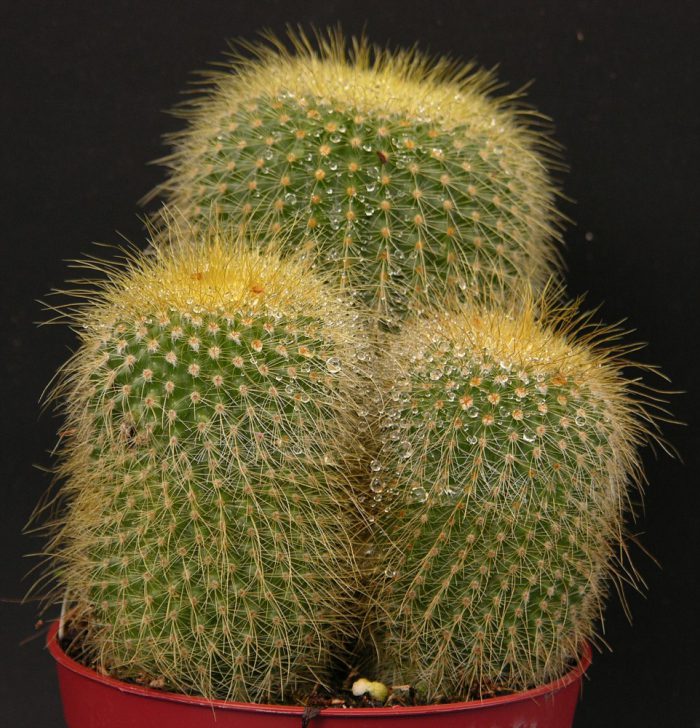

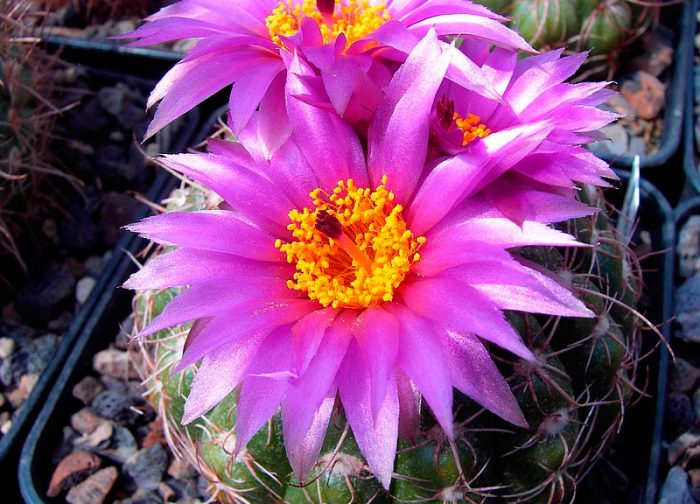
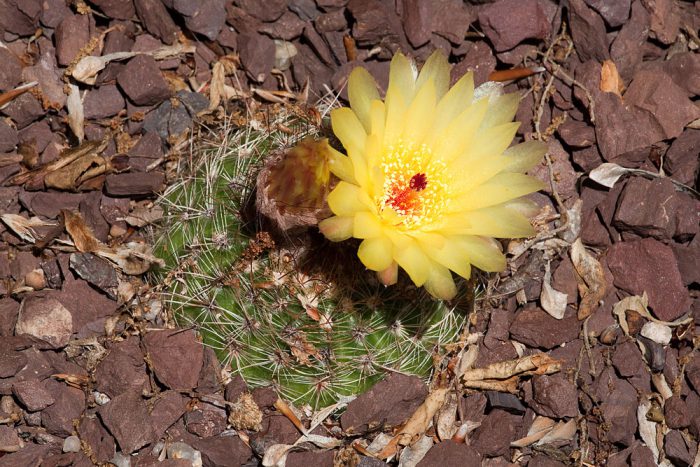
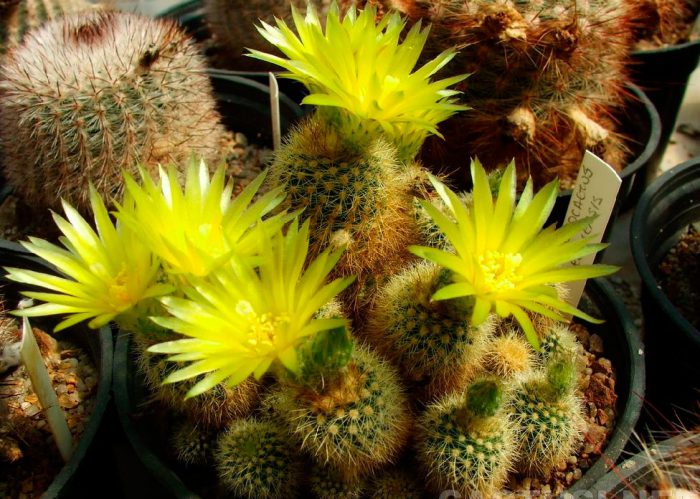
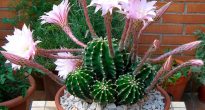

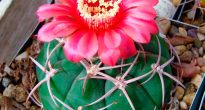
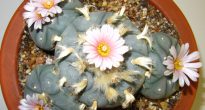
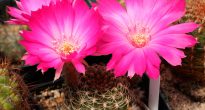



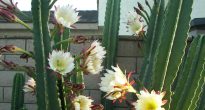

N. mammulosus and its varieties, N. submammulosus and its forms, N. scopa and its many varieties, N.horstii and a number of beautifully flowering species are completely undeservedly ignored. And, of course, the statement “This plant is not capricious and it is very easy to care for it” is extremely controversial. To grow a well-ringed plant of the correct shape is yes, it is quite possible. But it is not possible to achieve abundant and friendly flowering of all notocactus in the collection every season. Even while observing all conceivable and inconceivable know how.
I bought Haselberg's notocactus, but there is nothing about it ...